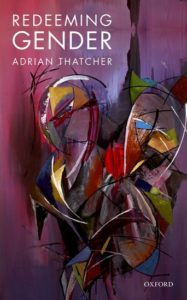Redeeming Gender
Adrian Thatcher. Redeeming Gender. Oxford: Oxford University Press, 2016, 225 pp. $35.95.
Reviewed by Micah Cronin
In Redeeming Gender, Adrian Thatcher considers the theological problems of androcentrism and patriarchy through the history of one-sex and two-sex theories. He relies on Thomas Laqueur’s hypothesis in Making Sex: Body and Gender from the Greeks to Freud—until the eighteenth century, humans were considered to be one-sex. Men were the default, more perfect rendering of that sex, while women were defective men. The two-sex theory, which may claim either the inequality or equality of two essentially different sexes, is an innovation of the modern period. In contrast, Thatcher seeks a christological and Trinitarian view of gender that resists the gender binary, accounts for human difference, and is egalitarian (141).
Thatcher first describes the workings of one-sex theory and its relevance to early Christian thought. Troublesome New Testament writings, such as Paul’s christological endorsement of the male/female hierarchy (1 Cor. 11:3) and his notion that women do not reflect the image of God in the same manner as men (1 Cor. 11:7), assumed the one-sex theory with its continuum of perfection (27–28). Various biological narratives were crafted to support this, and Aristotle incorporated them into his own conception of maleness and femaleness as principles rather than sexes. Biology, specifically the purported male role in conception, correlated with maleness’s natural superiority and femaleness’s natural inferiority (13–23). Such was Paul’s intellectual milieu, and Thatcher briskly illustrates the endurance of the one-sex theory through Tertullian, Aquinas, Kant, and Hegel, noting that such endurance demonstrates the disruptive innovation of the modern period’s two-sex theory (41–57).
Thatcher notes that in the history of one- and two-sex theories, Christian churches have not aligned themselves with one or the other, instead appealing to both in what he dubs the “modern mix” (84–112). This circumstance is problematic. To illustrate, Thatcher makes an example of Catholicism’s male-only priesthood. The Vatican affirms, on the one hand, the Nicene and Chalcedonian definitions of Christ’s “man”-hood as referent to his humanity. “Man” in the creeds is inclusive—neither the Greek nor the Latin mentions Christ’s sex. Yet this inclusive conception of Christ’s human nature is abandoned when it comes to the ordination of women. The Vatican asserts that women must be barred from the priesthood because Christ’s Incarnation took place “according to the male sex.” The weight given to Christ’s sex in this instance is not permitted by a creedal Christology, Thatcher claims. This move may prove useful to the orthodox Christian who seeks fresh and convincing theological ground for a gender inclusive priesthood.
Beyond the modern mix, Thatcher notes the strengths and deficiencies of the one- and two-sex theories separately. The one-sex theory has never existed without a scale of perfection privileging men to go with it, but its value does lie in its ability to affirm a single human nature against separate male and female natures (138)—the crux of Thatcher’s own proposal. Thatcher does not find the iteration of the two-sex theory, which proclaims two unequal sexes, worthy of discussion, but the egalitarian two-sex theory has serviced feminism successfully (especially in Western liberal Christianity). However, it still provides refuge for the increasingly problematic sex binary, oppositional sexism, intersex erasure, and heteronormativity (110–12, 139–40). Theology “can do better” (139).
Thatcher’s attempt to do better is the most exciting aspect of Redeeming Gender. In a creative application of orthodoxy, Thatcher makes three claims. The first is that the opening chapter of Genesis teaches the creation of a single humankind—not malekind and femalekind. The image of God is located in humankind, not reflected through complementary combinations of men and women. Thatcher also notes that there is no essence to women and men—except in their human nature. Orthodox Christology informs us that, following sin and God’s response to it in Christ, it is Christ who is the image of God. Thus, and secondly, Christ is the image and the essence of humankind (178–79). Through Christology, Thatcher moves us beyond theologically endorsed gender essentialism and its resultant hierarchies. Yet, those readers who claim any politicized identity may still be suspicious—is this proposal a form of theological identity erasure, a violence so often perpetrated against those of subjugated identity groups? To this question, Thatcher responds in the negative. Difference remains in Christ’s renewed humanity, and it becomes “a means of communion” (178). Here Thatcher illustrates how the life of the Trinity illuminates for humankind the redeemed dynamic of identity and difference. The redeemed life offered by the gospel is “life in communion, as God’s life is in communion” (183). Thatcher finds the meaning of “communion” in the Athanasian Creed. Its insistence that the Persons are one, yet that each have a “strong identity” means that each Person’s individuality “is not actualized at the expense of the others” (182), nor must difference be a problem to be dealt with by erasure or domination, because each Person is “in the one Life that pours itself out in self-giving Love” (186). This is the communion Christians are drawn into.
Redeeming Gender is a creative, orthodox, and sustainable theology of gender. Readers may find it strange that transgender, nonbinary, and intersex people enjoy only a limited presence in the work. However, this is due to Thatcher’s aim to deconstruct the problem behind our gender troubles—the gender essentialism which underpins the two-sex theory. In doing so, Thatcher has delivered on his promise to produce a theological approach to gender as a single continuum which adequately resists oppressive gender hierarchies while valuing identity and difference.
Micah Cronin, MDiv Student, Princeton Theological Seminary

